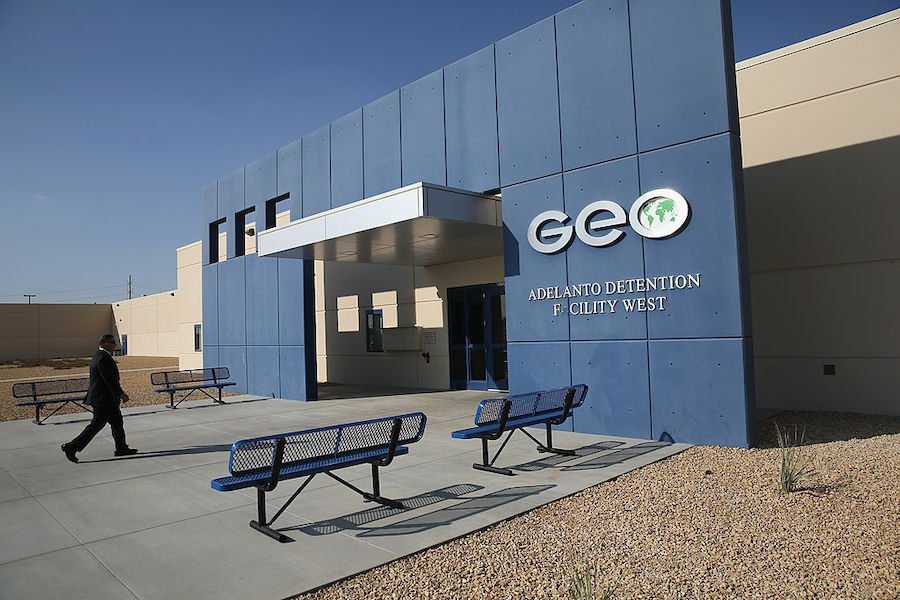Private Prisons Are a Dead-End Economic Recovery Model. Just Ask This California Town.
Conner Martinez

Driving into the rural community of Adelanto, Calif., you are greeted by a large sign that reads “Adelanto, The City With Unlimited Possibilities.” Unfortunately, the sign’s statement is incompatible with the environment surrounding it, a seemingly endless desert with sparse housing, almost no community spaces and a massive immigration detention center.
Adelanto’s reality may finally change, however, with a new bill (AB 32) banning private prisons, including immigrant detention centers, passed by the legislature September 11, and now expected to be signed by Gov. Gavin Newsom (D). Though the effects are uncertain, the bill’s passing could mean Adelanto’s detention center closing as early as next March. That would not only put an end to the consistent human rights violations committed inside the facility, but it would also end the city’s long, failed attempt at using detention as a development strategy, providing an example for other rural communities across America who have gone down the same disastrous path.
In 2010, the city of Adelanto was in desperate need of a new start to their economy after the financial crisis, and officials decided to sell the city-owned prison to the Florida-based private prison company, GEO Group. The deal was for $28 million, and according to city officials was made to foster economic growth. “The $28 million will help relieve some of the financial stress on the city,” said then-Adelanto City Manager Jim Hart.
But the detention center has failed to bring the economic opportunity it promised. Currently, the city’s poverty rate is 38.5%, 18% higher than in neighboring Los Angeles, and the city is facing a $4 million structural deficit.
The facility, meanwhile, has ballooned to hold nearly 2,000 beds, a number roughly tripled from the original 650. “It’s notoriously been plagued with scandal since its inception” says Liz Martinez, the director of advocacy and strategic communications for Freedom for Immigrants, a nonprofit devoted to the abolition of immigration detention.
In a recent surprise visit from the Office of the Inspector General, various human rights violations were observed in the Adelanto facility, including medical neglect, the continued presence of nooses despite multiple suicide attempts, and excessive use of solitary confinement as punishment. After three deaths at Adelanto in 2015, ICE reviewed the cases and found “medical care deficiencies related to providing necessary and adequate care in a timely manner.”
“It’s basically hell on earth,” says Martinez. “Municipalities should not be involved in [private detention]. Rather, they should be investing in their communities.”
In March, the city of Adelanto announced it would be ending its agreement with Immigration and Customs Enforcement (ICE) and GEO Group to manage the Adelanto ICE Processing Center. Although on this surface this may have looked like a victory, it quickly became clear the result could make the situation worse. The split was partly orchestrated by GEO Group as a way to circumvent the Dignity Not Detention Act, a bill strictly regulating whether and how local governments could contract with private detention centers. With GEO Group and ICE now free to contract directly, the facility is no longer legally obligated to meet the same standards of treatment for detained individuals. (As noted above, however, a new California law could bar GEO and ICE from renewing their new contract next year.)
Speaking about the contract termination, Lizbeth Abeln of the Inland Coalition for Immigrant Justice (ICIJ) said that “community members were not educated on any of the impacts [ending the contract] may have on them,” and that “they were just told, yes, this is good, we will get money for the city.”
Just weeks before city officials made the decision, GEO Group’s CEO George Zoley emailed Adelanto officials requesting the termination of their contract.
“We believe GEO has been a good partner for the City by creating several hundreds of jobs and significantly contributing to the City’s financial well-being, particularly, when the times were very difficult. We continue to contribute through high school scholarships and to local charities. We now ask for your cooperation to discontinue the ICE IGSA [the contract between ICE and Adelanto],” Zoley stated in the email.
GEO Group, like other private detention companies, understands how leveraging cities’ economic anxieties against them is a profitable business plan. “I think companies like the GEO Group smell desperation, and they are very tuned in on cities that actually need companies to prop them up,” said Adelanto resident and native Mario Novoa. That vulnerability is what allows them to affect the decisions and priorities of local officials.
In Adelanto, for example, after the construction of the city’s first high school was approved in 2008, the opening was delayed from 2012 to 2014 due to the project going $3.4 million over budget. In comparison, the detention facility’s expansion project went over budget by $25.4 million, and was completed in four years.
When rural local governments prioritize detention facilities over schools, the answer to why their communities face higher levels of poverty, depression, drug addiction and suicide should be clear.
Incarceration goes rural
Unfortunately, Adelanto’s situation is little different than that of many other rural U.S. communities. When agriculture moved out and the great depression moved in, Adelanto went through economic trouble until it was propped up by the war economy. In 1941, the bordering community of Victorville began building the Victorville Army Airfield, later renamed the George Air Force Base. That made Adelanto the home of thousands of Air Force families, and created a dependable source of revenue for the city.
When the base was officially decommissioned in 1992, the City again entered an economic slump that has continued to this day. In an act of economic desperation, Adelanto made the choice many rural communities did in the 1990s: It became a prison town. In 1991, the city contracted with the state of California to construct the Adelanto State Prison.
Throughout the 1980s and ’90s, many local governments in rural communities across the United States worked with the state and federal government to secure prison contracts. From 1980 to 1991 there were 213 prisons built in non-metro areas in the U.S. Many of them came with massive accommodations from local government.
In one instance, the town of Abilene, Texas, offered an incentive package worth over $4 million to the state of Texas to attract the construction of a prison. The plan also included 1,100 acres of farmland capable of producing $500,000 in cotton a year. One major reason for this was the steady increase of incarceration rates since 1980. Statistics from the Bureau of Justice show that the prison population rose more than 300% from a record high at the time 329,122 inmates in 1980, to 1,489,363 inmates as of 2017.
From prison to immigrant detention
Today, the hyper-criminalization of migration by the Trump administration has created a new opportunity for rural communities to choose detention as a development strategy. “Both on the border and in the interior you are seeing a massive surge of detention expansion,” says Liz Martinez of Freedom for Immigrants.
From 2000 to 2016 — before Trump even took office — the number of immigrants in detention rose 442% from 4,841 to 26,249. With the economic outlook of many rural communities still bleak, detention can seem a wise investment.
In March, the rural Village of Dwight, Ill., approved the construction of a 1,200-bed immigration detention facility. In response to statewide protests against the facility, Village President Jared Anderson cited economic development as the reason the vote passed. “You are looking at $60,000-a-year salaries. That’s a good wage that would bring people into Dwight and give them an opportunity to have a house in town,” Anderson stated.
However, the jobs Anderson is talking about require prior experience and high levels of education. What is more likely to occur is the same thing that happened to Adelanto: a staff formed mostly of out commuter workers, which contributes little to the town’s economy. “The other big question is how many people that work at the detention center actually live in Adelanto,” as community member Mario Novoa pointed out.
Multiple studies on prison towns show that well below half of prison jobs are given to the communities’ current residents.
A study drawing on 25 years of data on New York’s rural prison communities by researchers from The Sentencing Project found that “residents of rural counties with one or more prisons did not gain significant employment advantages compared to rural counties without prisons.”
“The statement that ‘we bring more jobs’ is not accurate,” Lizbeth Abeln of the ICIJ stated, adding that “most of the people don’t last long working there because it’s disorganized, mismanaged, and they just don’t like the working environment. So if we’re going to talk about jobs, these aren’t the jobs people want.”
Also, working in a detention center or prison poses a serious threat to the health of the residents who do receive jobs.
A 2017 report from the Marshall Project has shown that 65% of correctional officers say they have symptoms of PTSD, and three of four have seen a death or serious injury occur at work. In 2013, the California Correctional Peace Officers Association reported that the suicide rate among its member was 19.4 deaths per 100,000, compared to 12.6 deaths among the U.S. general public. On Glassdoor, an online website where previous employees can review jobs, Geo Group employees in California rate their jobs one and a half stars out of five, and only five percent of reviewers recommend the job.
For detainees, the situation is worse. In response to reports on abuses within the prison, Liz Martinez said that “one of the things that was the most chilling was the unvarnished cruelty of the way the staff and guards were treating people.” A report from Human Rights Watch has shown that poor medical treatment was a major factor to more than half of the deaths reported by ICE during a monitored 16-month period. Not only are there almost no regulations within these detention centers, but those detained also are denied their legal rights, such as the right to free representation or the use of phones to communicate with lawyers.
“I’ve seen a few attempted suicides using the braided sheets by the vents and then the guards laugh at them and call them ‘suicide failures’ once they’re back from medical,” one Adelanto detainee told an inspector from the DHS Office of the Inspector General.
As for the economic growth prisons and detention centers promise to bring, the results are also inconsequential. The same research by The Sentencing Project showed that in the case of New York, from “1982 until 2000, per capita income rose 141% in counties without a prison and 132% in counties that hosted a prison.”
Changing the meaning of progress
While recent legal developments make the future of Adelanto’s detention center uncertain, the city must still continue its uphill battle against a struggling economy.
One new hope Adelanto has found in an effort to turn away from detention is marijuana. In 2015, the city of Adelanto became one of the first in California to permit the growth of medical cannabis. In 2017, Mayor Richard Kerr said he wanted to turn the city into the “Silicon Valley of medical marijuana,” but then in 2018 Kerr was taken out of his house in handcuffs on the charges of corruption.
So far, the community is skeptical about the cannabis industry. “With the cannabis industry, we have to make sure those companies are paying their taxes so that Adelanto has a good revenue going,” says Abeln of the ICIJ. Instead of an industry like cannabis, Abeln believes that “focusing on community institutions like schools and parks and recs [and] mental health facilities” will help build a better Adelanto.
Translated to English, Adelanto means progress. While that definition seems hollow now, residents and activists still believe that progress and opportunity are possible in Adelanto.
“When it comes to the news, you have moderate or left voices that are talking about Adelanto in a negative connotation because the GEO Group is attached to it,” Novoa says. “What does that do to the psyche of the community?”
Abeln agrees. “Whenever someone hears Adelanto they don’t think about the positive things, they think about the detention center and the deaths that have occurred there. The residents know this, and it puts a kind of gray cloud over the city and it blocks growth.”





